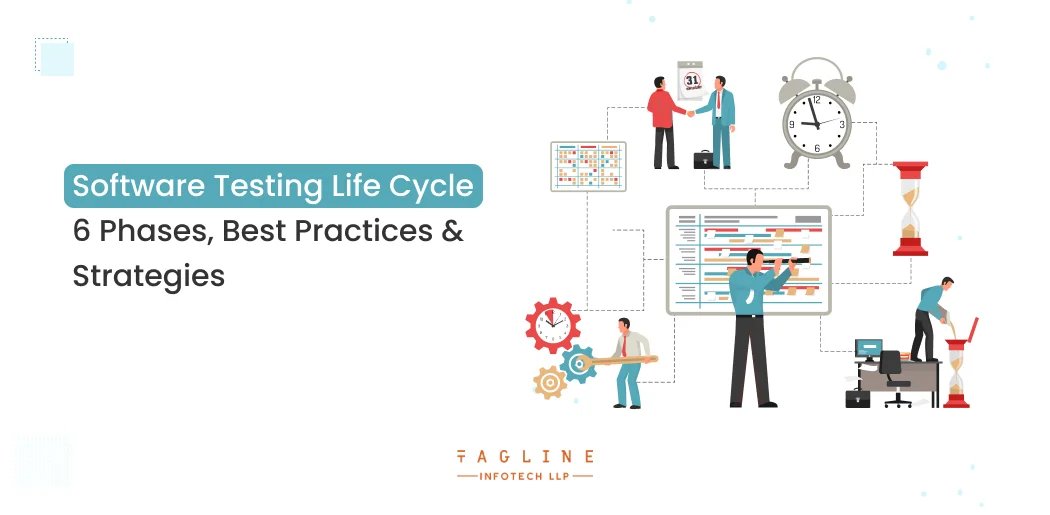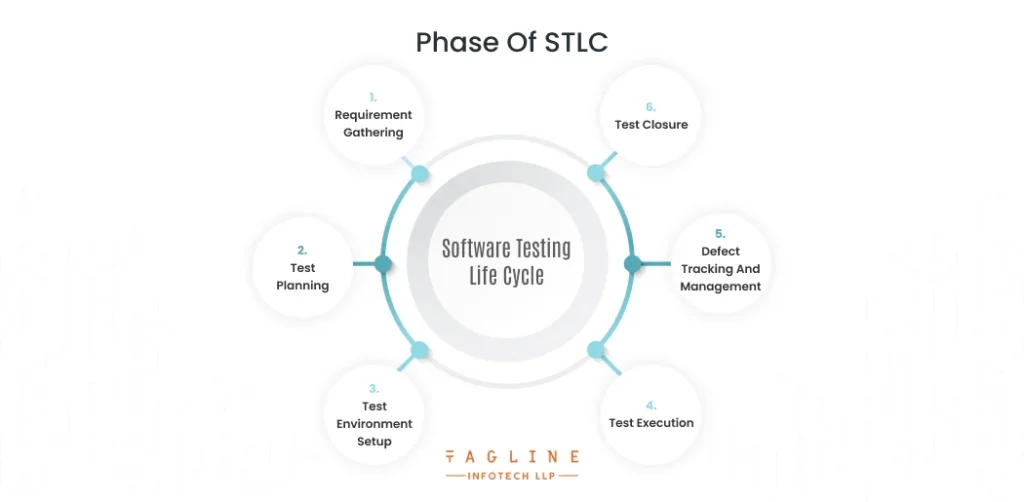Role of Python Libraries in Image Processing
October 30, 2025
Home >> Software >> Software Testing Life Cycle: 6 Phases, Best Practices & Strategies

Introduction
STLC testing called Software Testing Life Cycle.
The STLC is a testing technique that can help you satisfy software quality requirements more effectively. STLC requires systematic testing, which is done in stages.
STLC is sometimes mistaken for Software Development Life Cycle (SDLC), although whereas STLC focuses on testing, SDLC includes all stages of development.
Continue reading for an in-depth examination of the STLC life cycle and its six stages.
The STLC is a critical procedure that aids in the quality assurance of software applications and provides a systematic method of testing.
It enables businesses to produce high-quality software that fulfils the demands of their customers, resulting in customer happiness and company success.
A life cycle of software testing is similar to the series of transformations that an entity goes from one form to another. Many tangible and enigmatic creatures go through a succession of transformations from beginning to end.
When we discuss the cycle of testing, we refer to the program as an entity. The software testing life cycle steps (STLC) outline the various phases involved in carrying out actions during the testing process.
One of these activities is checking the created software to verify if it fits specified criteria.
When there are flaws in the product, testers collaborate with the development team.
In other circumstances, they must contact the stakeholders to acquire insight into various product specifications. The cycle of testing also includes mechanisms for product validation and verification.
Entry and exit criteria are linked with each of the six phases of a software test life cycle. Testers must complete the test cases within a specific time frame.
They must also maintain the finished product’s quality, usefulness, and efficiency. As a result, specifying admission and exit criteria is essential. That’s exactly what we’ll do immediately.
Entry Criteria
The entry criteria specify the team’s conditions before beginning the testing procedure. Before testing can begin, all prerequisites must be checked off.
Before testing may begin, certain continuous actions and requirements must be met. First, you’ll need feedback from the development team.
You should also look at the test plan, test cases and data, testing environment, and code.
Exit Criteria
Exit criteria provide the requirements and tasks that must be completed before the testing is completed. In other words, they involve tasks to complete and processes to perform before testing is completed.
The identification of high-priority faults will be one of the exit criteria.
You’ll need to have things corrected as soon as possible. Testers must pass various test cases while ensuring comprehensive functional coverage.
Also Read : Which Is Better: Manual Testing vs Automated Testing?
The testing team analyses and specifies the scope of testing, entrance and exit criteria, and test cases at the early phases of cycle of testing, while the software product or application is being built.
It contributes to shorter test cycle times while also improving product quality. As soon as the development phase is over, the testing team prepares test cases and begins execution.
This aids in the early detection of bugs.

To ensure product precision and correctness, every module of software or program must be validated. Because software testing is a complex procedure, testers perform it in the following stages:
The accessible specs and requirements must be seen, studied, and analysed by your important software testers. Certain criteria generate results by giving them input data.
These are requirements that can be tested. Testing professionals investigate both functional and non-functional needs. Following that, they must choose testable requirements.
This phase involves brainstorming for requirement analysis and identifying and prioritising test needs. They also consist of identifying criteria for both automated and manual testing.
Even if they are not expressly stated, there are a few things you must test. A click on an active button should accomplish something, and a text field for a phone number should not accept input alphabets.
You may decrease waste by ensuring that every testing effort is linked to a need that provides value for the client. To summarise:
The second phase is test planning, created by the QA team after analysing the relevant testing requirements.
After understanding the product domain, they establish the scope and objectives.
The team analyses the risks involved and establishes timetables and testing settings to develop a plan.
Following that, management finalises the tools and assigns personnel jobs and tasks. There is also an approximate schedule for completing the testing of each module.
The test plan, a document describing the objective and specifics of the testing operations for a certain project, is the most essential item created in this stage. To summarise:
Certain environmental components, including servers, frameworks, hardware, and software, are required for testing operations to be carried out.
It is also required to smoke test and provide problem-reporting tools to your testers. It’s frequent in the development community to hear, “It ran on my system, but it’s not running on yours.”
As a result, your test environment must encompass all the environments the user may encounter. Some features, for example, that operate in Google Chrome do not work in Internet Explorer.
A function may run properly with 4 GB RAM but may cause problems with 1 GB RAM. End-user environments should be researched to assist you in prioritising your test settings.
Boost Your Business with Correct Software Solutions!
Our team of proficient software developers creates software that aligns perfectly with your specific requirements, elevates productivity, and boosts profitability!
The application is ready for testing when the team has completed all of the preceding processes. Test cases are executed by testers according to the test plan.
They also locate, detect, and log problems, resulting in bug reports. The team is also in charge of comparing projected results to actual results.
If any bugs are discovered, they must be documented so that the development team can fix them.
Regression testing begins after the development team has removed an issue. Regression testing ensures that the software or application continues to function after a change has been implemented.
When testing after a problem repair, retest the entire product. Because a bug patch may introduce a problem in another product component.
Because the same tests must be run repeatedly after each change and release, scripts or automated testing tools like Selenium are suggested.
The major deliverables in this phase are the test findings, which should ideally be confirmed and distributed automatically. To summarise:
The software testing lifecycle management includes the Defect Tracking and Management phase, which is devoted to efficiently tracking and resolving issues found during the testing process. During this segment, any found faults or flaws are methodically noted to make sure that everyone is thoroughly documented.
Defects are classified consistent with their severity and effect on software capability, offering clean know-how in their criticality. These faults are then categorized and allocated to the improvement team at the price of addressing them.
After the development group has addressed the failings, they go through a verification and validation procedure to verify that they’ve been resolved effectively and that no new issues have been added.
This segment performs a pivotal function in preserving the software program’s best and making sure that it meets the preferred standards before being released to end customers.
The last step of the STLC is test closure, in which all testing-related tasks are finished and recorded. The test closure stage’s major goal is to guarantee that all testing-related activities have been finished and that the programme is ready for release.
The testing team should have a clear knowledge of the software’s quality and dependability by the end of the test closure stage, and any flaws or issues discovered during testing should have been remedied.
Documenting the testing process and any lessons gained so that they may be utilised to enhance future testing procedures is also part of the test closure step.
Simply detecting mistakes at the end of an SDLC is no longer an efficient practice. You should hire software developers who can build fully functional software for the growth of your business.
A company must also focus on a variety of other everyday operations. Devoting too much of your valuable time to testing and issue fixing might reduce efficiency. After all, it will take more time to produce less product.
It is critical to use time and resources to facilitate the testing process. Following a systematic STLC process not only results in faster issue fixes but also improves product quality.
You will benefit from greater ROI and brand exposure by enhancing client satisfaction.
Entry and go-out standards are important in STLC as they define where a checking-out segment needs to start (entry standards) and where it should end (go-out criteria). These criteria ensure that trying out is initiated below the right conditions and that checking out activities are completed satisfactorily before proceeding to the subsequent phase.
Some nice practices for STLC include thorough requirement analysis, early involvement of testers inside the development technique, automation of repetitive check instances, non-stop verbal exchange among development and testing teams, and comprehensive documentation of test instances and consequences.
Created with Solvase

Digital Valley, 423, Apple Square, beside Lajamni Chowk, Mota Varachha, Surat, Gujarat 394101
D-401, titanium city center, 100 feet anand nagar road, Ahmedabad-380015
+91 9913 808 2851133 Sampley Ln Leander, Texas, 78641
52 Godalming Avenue, wallington, London - SM6 8NW